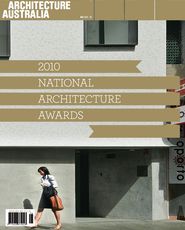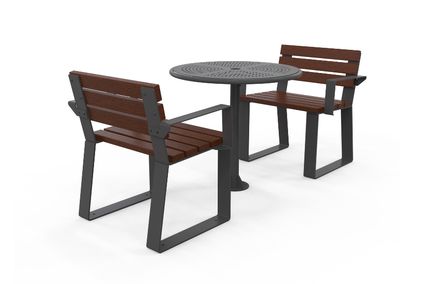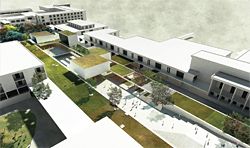
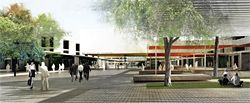

UNIVERSITY OF CANBERRA CONCOURSE AND SITING OF KEY BUILDINGS, WINNING ENTRY BY MORQ.
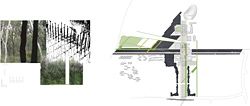

UNIVERSITY OF CANBERRA LANDSCAPE CHARACTER PLAN (ABOVE) AND UNIVERSITY GREEN (BELOW), WINNING ENTRY BY MARK TYRRELL AND SHARON WRIGHT.
Annabelle Pegrum discusses the role of competitions in procuring design, with the recent University of Canberra campus competition as a case study.
Wherever you are in Canberra, whenever you look up, you are connected to the landscape and the great panorama of the city. It is part of the brilliance of the place that – in nearly a century of development, through successive political regimes and planning themes and dreams – this powerful idea of the landscape city remains robust and always evident.
The gentle rolling hills that embrace and frame, the great expanse of sky, the ever-present sense of the bush beyond and the gardens within – it was a design competition that delivered this Canberra. It was a design competition that introduced Australia, and arguably the world, to the extraordinary Walter Burley Griffin and Marion Mahony Griffin. You have to marvel at the courage or sheer hubris of those politicians who in 1912 put the city of their imagination to the test of the design talent of the world. Whatever the flaws of the process, they got this right. The winning Griffin design for Canberra is that one big idea that makes you believe in the possibilities of greatness and makes all other entries appear somewhat clumsy.
Canberra remains a testament to the value of design competitions, open or invited, national or international. The Australian War Memorial, the National Carillon, the National Gallery, the High Court, the National Museum, the Portrait Gallery, Commonwealth Place, Reconciliation Place, the memorials on Anzac Parade, the National Arboretum (a wonder in the making) and of course Parliament House. Each is the product of a competition, all are memorable and most have been recognized with awards.
In 2001, as part of the centenary initiatives, the National Capital Authority, of which I was then chief executive, made a commitment to creating “opportunities for Australians to lead” by affirming competitions as central to its procurement of design. I remain a believer in design competitions. I have seen first-hand the extent to which they elicit quality discourse and inquiry, encourage and discover new talent, target and inspire the best in experienced designers and unearth remarkable solutions to complex challenges.
There are of course some key ingredients to the success of competitions. The Australian Institute of Architects and the Australian Institute of Landscape Architects have gone to some lengths to articulate these in guidelines for their conduct; any decent competition should have their endorsement. However, three things are, I think, critical. Firstly, the design can only be as good as the brief. Thoughtful reflection and inquiry are fundamental, and in my experience the brief is best when it is a simple statement about the “intent” and “creative idea” rather than a litany of space schedules and feasibility studies. The search for the one really good design needs to be as exploratory as is possible.
A second essential ingredient is the nature of the jury. Design professionals expect and generally welcome critique. Awards are about celebration and peer review. Opinion is encouraged and debate central to engagement. All of this means that in a competition, scrutiny of the jury for its composition, intellectual capital and collective experience may be enough to limit or expand the field of entries.
Finally, in an ideal world the winning designer should be commissioned and the work built. In “design ideas” competitions it is not always possible to commit to engagement but it is important to be up-front about the potential for a commission. At first the relationship between client and designer can be one of awkward overtures before the relationship is founded, especially in a blind competition where the winner may be unknown to the client or inexperienced in project delivery. Regardless, both parties must persevere with good will so that the design can be realized with integrity. No doubt procurement through competition can be fraught – witness the struggle of Jørn Utzon and his masterful Opera House or for that matter of the Griffins in the “execution” of their design. Despite these classic examples of bureaucratic failures in delivery, and without beating a drum, the built works remain outstanding.
In the contemporary context, Australian university campuses have emerged as great platforms for innovative urban design and architecture. Universities are underpinned by philosophical premise, have captured populations and today reach out to the wider community. Many are sited on vast tracts of land or are fortuitously in the heart of buzzing urban areas. The experience and “look and feel” of the campuses are fundamental to their success as educational institutions of choice. The benchmark set by Leon van Schaik at RMIT deserves mention. He is to be congratulated for commissioning design that presents the university as a hothouse for exploratory architecture. Not surprisingly, many universities have embraced design competitions as part of their rejuvenation and development tool kit.
Back in the national capital, the University of Canberra is in a swirl of growth and renewal. Much more than a coming of age, the place has a sense of energy in which all things are possible. Under the leadership of Vice-Chancellor Stephen Parker, academic programs, profiles and research have been strengthened, student numbers have increased dramatically, new ties with other tiers of education are being forged, the larger region embraced – and the campus environment recognized as vital to the future. Last year a campus masterplan was endorsed and the position of University Architect established.
The UC campus is an intriguing place. The more time you spend there, the more you appreciate the original 1968 Hassell McConnell design. Within the 118 hectares of largely open space, the substantial concourse enclosed by formal modernist buildings remains the heartland for students and staff. It is the front and backyard of the campus, successfully mixing public and private space. Part of the city aesthetic, the campus is indivisible from the wider landscape. The distant hills provide a rare borrowed landscape and kangaroo herds still emerge from the wooded areas.
Yet, like so many other universities, the campus environment must shift to accommodate changing aspirations and needs. Outside of the core, the usual devil business of access and car parks and growth needs structure and attention. The concourse and the landscape require definition to secure the natural attributes, imbue a distinctive character and accommodate expansion, all of which calls for an intelligent and imaginative response. As part of that response, the university embarked on an ambitious campus design ideas competition. Thirty-five entries were received from all over Australia from architects, landscape architects, professionals and students. As anticipated, the results demonstrated the remarkable diversity and ingenuity of designers, with solutions that stretched the potential of the design brief.
The competition was unusual, evolving as a series of “design modules”. Competitors were required to enter a mandatory module for the central concourse and then had the discretion to submit for all or none of six other modules. These included a landscape character plan; selecting sites for key future buildings such as a chancellery, library and great hall; and ideas for the university green. The primary objectives were to create a striking and stimulating heartland and to establish a strong physical identity and presence for the campus proper. A separate statement of design intent was drafted for each module – some more successful than others in eliciting innovative responses.
The jury included architects, landscape architects, graphic designers and those with experience in the environment, culture and the arts. A panel of design students judged the entries independently, with their selection counting as one vote. At the end of an invigorating two days of discussion, the jury awarded prizes to two entrants, each winning two modules, and also gave three supplementary prizes.
MORQ won the modules for the Concourse and the Siting of Key Buildings. Their concourse design is a highly sophisticated and integrated set of spatial proposals, presenting a strong and elegant vision that is unique to the place and respects the existing built fabric. It creates places of different character within a unified construct and cleverly interlocks with the city grid and the wider campus.
Mark Tyrrell and Sharon Wright won the modules for the Landscape Character Plan and the University Green. Their landscape plan is a powerful and poetic proposal that defines the campus from within and without, drawing with a genuine certainty upon the Canberra bush setting and regional landscape.
The winning entries are from teams of emerging designers – visionary ideas that deserve to be developed further. As the jury noted, although conceived separately, the designs subtly complement each other and could work well together. To that end the university has commissioned the teams for a week-long collaborative workshop to develop their proposals.
Competitions have earned a valued place in the procurement of innovative design. Sometimes controversial, nevertheless they remain a worthy source of creativity and talent in the pursuit of excellence in architecture and design.
Annabelle Pegrum is a Professorial Fellow of the University of Canberra and the University Architect.
The jury report for the University of Canberra Campus Design Ideas Competition is online at www.canberra.edu.au/campus-design.
In addition to the two winners, three special mentions were made – Colin Stewart Architects; Philip Ayling, Stuart Drury and Stuart Mason; and Charles Dewanto, C J Foo, Lorenzo Ju, Yenny Kusuma, Louis Wong, Maggie Chu and Tze Ek Ng.

